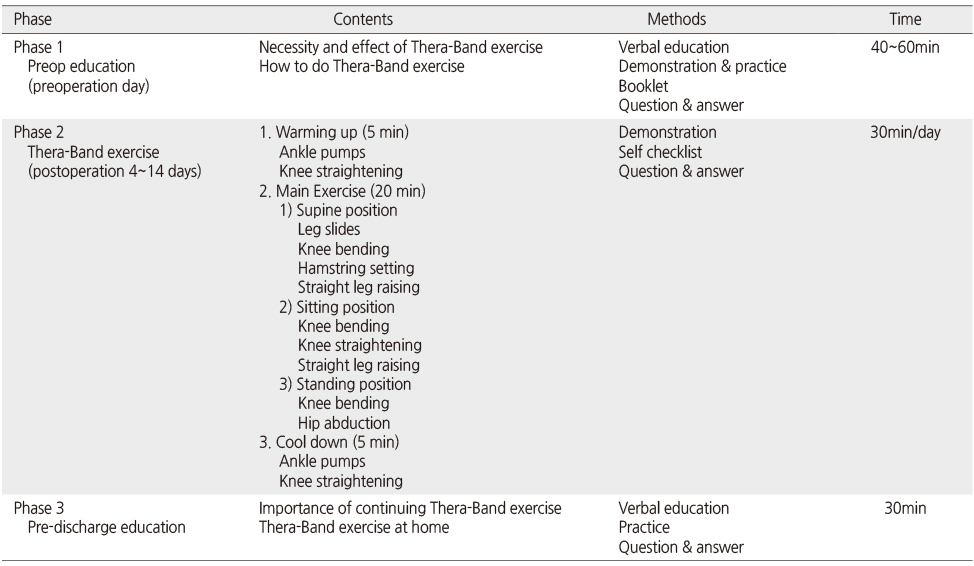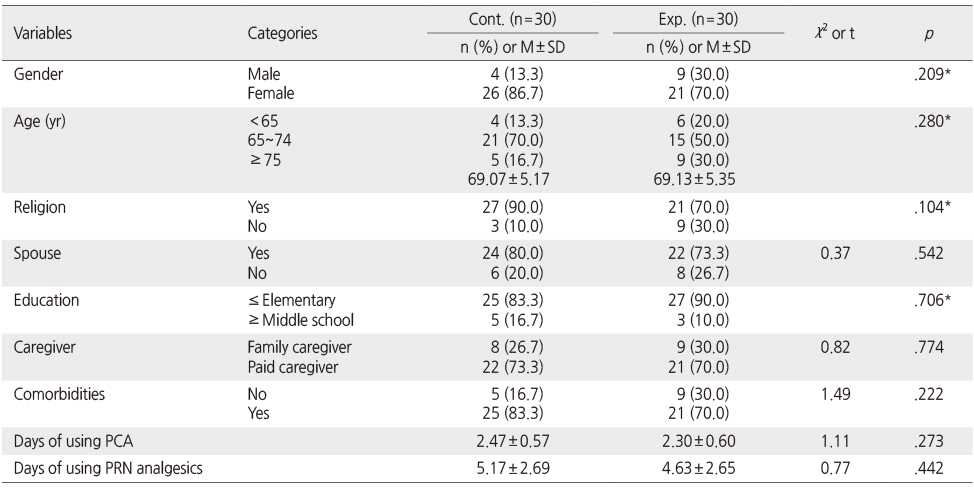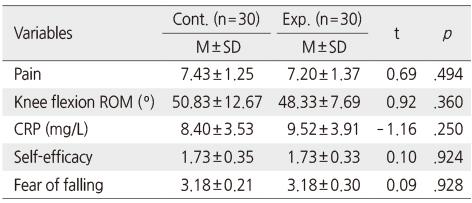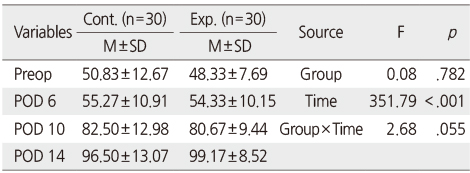Articles
- Page Path
- HOME > J Korean Acad Nurs > Volume 45(6); 2015 > Article
-
Original Article
- Effects of a Thera-Band Exercise Program on Pain, Knee Flexion ROM, and Psychological Parameters Following Total Knee Arthroplasty
- Ji Yeong Yun, Jong Kyung Lee
-
Journal of Korean Academy of Nursing 2015;45(6):823-833.
DOI: https://doi.org/10.4040/jkan.2015.45.6.823
Published online: December 31, 2015
1Department of Nursing, Graduate School, Dankook University, Cheonan, Korea.
2Department of Nursing, Dankook University, Cheonan, Korea.
- Address reprint requests to: Lee, Jong Kyung. Department of Nursing, Dankook University, 119 Dandae-ro, Dongnam-gu, Cheonan 31116, Korea. Tel: +82-41-550-3883, Fax: +82-41-550-3888, kyunglee@dankook.ac.kr
© 2015 Korean Society of Nursing Science
This is an Open Access article distributed under the terms of the Creative Commons Attribution NoDerivs License. (http://creativecommons.org/licenses/by-nd/4.0/) If the original work is properly cited and retained without any modification or reproduction, it can be used and re-distributed in any format and medium.
Abstract
-
Purpose
- The purpose of the study was to investigate the effects of the Thera-Band exercise program following total knee arthroplasty.
-
Methods
- The research design for this study was a nonequivalent control group non-synchronized design. Participants were 30 patients for the experimental group and 30 patients for the control group. The experimental group participated in the Thera- Band exercise program in addition to conventional CPM (continuous passive motion) exercise. The control group received conventional CPM exercise only. Outcome measures were pain, knee flexion range of motion, CRP, and psychological parameters (self-efficacy and fear of falling). Data were analyzed using χ2-test, Fisher's exact test, t-test, and repeated measure ANOVA with SPSS/PC version 21.0.
-
Results
- There were significant improvement in self-efficacy, and decreases in pain, and fear of falling in the experimental group compared to the control group. However, no significant differences were found between the two groups for CRP and knee flexion ROM.
-
Conclusion
- The Thera-Band exercise program gave an additional benefit over the conventional CPM exercise for patients following total knee arthroplasty, and is recommended for use as an effective nursing intervention for patients after total knee arthroplasty.
*This manuscript is an addition based on the first author's master's thesis from Dankook University.
The authors declared no conflict of interest.
- 1. National Health Insurance Service. Main surgery statistical yearbook for 2013 [Internet]. Seoul, Author. 2014;cited 2014 December 31. Available from: www.nhis.or.kr/menu/boardRetriveMenuSet.xx?menuId=F3326.
- 2. Bade MJ, Kohrt WM, Stevens-Lapsley JE. Outcomes before and after total knee arthroplasty compared to healthy adults. J Orthop Sports Phys Ther. 2010;40(9):559–567. ArticlePubMedPMC
- 3. Noble PC, Gordon MJ, Weiss JM, Reddix RN, Conditt MA, Mathis KB. Does total knee replacement restore normal knee function? Clin Orthop Relat Res. 2005;431:157–165. Article
- 4. The Korean Orthopaedic Association. Rehabilitation after total knee arthroplasty [Internet]. Seoul, Author. 2015;cited 2015 March 10. Available from: http://www.koa.or.kr/info/index_10_7.php
- 5. Vancouver Coastal Health. Exercise guide for knee replacement surgery. Vancouver, CA: Author; 2005.
- 6. Jeon SJ, Choi KS, Ko SK. The effect of rehabilitation training on knee muscular strength and function recovery after total knee arthroplasty. Korea Sports Res. 2005;16(4):441–448.
- 7. Maniar RN, Baviskar JV, Singhi T, Rathi SS. To use or not to use continuous passive motion post-total knee arthroplasty presenting functional assessment results in early recovery. J Arthroplasty. 2012;27(2):193–200. e1PubMed
- 8. Herbold JA, Bonistall K, Blackburn M, Agolli J, Gaston S, Gross C, et al. Randomized controlled trial of the effectiveness of continuous passive motion after total knee replacement. Arch Phys Med Rehabil. 2014;95(7):1240–1245. ArticlePubMed
- 9. Chung MS, Kwak HS. Effects of a muscle strengthening exercise program after total knee arthroplasty. J Korean Acad Soc Nurs Educ. 2008;14(1):20–29.Article
- 10. Ford ES. Does exercise reduce inflammation? Physical activity and C-reactive protein among U.S. adults. Epidemiology. 2002;13(5):561–568. ArticlePubMed
- 11. Kim KT, Cho JH. The effect of elastic band and aerobic exercise on fitness, blood lipids, and vascular inflammatory markers in elderly women. Off J Korean Acad Kinesiol. 2013;15(2):129–138.
- 12. Kim YJ, Yoon MN, Han SS. Effects of Thera-Band(R) resistance training including isometric exercise in total knee replacement patients. Korean J Health Promot. 2011;11(2):82–90.
- 13. Page P, Ellenbecker TS. The scientific and clinical application of elastic resistance. Champaign, IL: Human Kinetics; 2003.
- 14. Yun HD. The effects of isometric exercise and isotonic exercise using elastic band on strength, range of motion, standing balance for the patient with chronic knee arthritis [master's thesis]. Yongin:, Dankook University. 2006.
- 15. Chang TF, Liou TH, Chen CH, Huang YC, Chang KH. Effects of elastic-band exercise on lower-extremity function among female patients with osteoarthritis of the knee. Disabil Rehabil. 2012;34(20):1727–1735. ArticlePubMed
- 16. Kim HG, Nam HK. The effect of thera band exercise on muscle flexibility, balance ability, muscle strength in elderly women. J Korean Acad Community Health Nurs. 2011;22(4):451–457. Article
- 17. Kwon MS. Effects of a fall prevention program on physical fitness and psychological functions in community dwelling elders. J Korean Acad Nurs. 2011;41(2):165–174. ArticlePubMed
- 18. LeMaitre JP, Harris S, Fox KA, Denvir M. Change in circulating cytokines after 2 forms of exercise training in chronic stable heart failure. Am Heart J. 2004;147(1):100–105.ArticlePubMed
- 19. Oh HA, Kim JI. The relationship among the health promoting behavior, pain, self-esteem, family support and self-efficacy in patients with chronic arthritis. J Muscle Joint Health. 2004;11(1):50–60.
- 20. Tideiksaar R. Falling in old age: Prevention and management. 2nd ed. Ronkonkoma, NY: Springer Publishing Company; 1997.
- 21. Choi JH, Moon JS, Sohng KY. The effects of Tai Chi exercise on physiologic, psychological functions, and falls among fall-prone elderly. J Rheumatol Health. 2003;10(1):62–76.
- 22. Han SS, Her JJ, Kim YJ. Effects of muscle strengthening exercises using a thera band on lower limb function of hemiplegic stroke patients. J Korean Acad Nurs. 2007;37(6):844–854.ArticlePDF
- 23. Bruun-Olsen V, Heiberg KE, Mengshoel AM. Continuous passive motion as an adjunct to active exercises in early rehabilitation following total knee arthroplasty: A randomized controlled trial. Disabil Rehabil. 2009;31(4):277–283. ArticlePubMed
- 24. Kim SK, Lee SW, Kim JH. Effects of rehabilitation exercise program on back pain and inflammatory markers in workers with occupational low back pain. Korean J Health Promot. 2010;10(3):131–138.
- 25. Lee JW. The effect of aerobic exercise and type of band exercise on inflammatory markers of elderly women patients with metabolic syndrome. Korean J Sports Sci. 2011;20(4):1041–1053.
- 26. Lee HY. Effects of a rehabilitation nursing program on muscle strength, flexibility, self efficacy and health related quality of life in disabilities. J Korean Acad Nurs. 2006;36(3):484–492.ArticlePDF
- 27. Yoo MS, Chae SM, Kim YS. The effects of an exercise program on joint angles, blood pressure, and self-efficacy in elderly community-dwelling adults. J Korean Acad Soc Home Care Nurs. 2008;15(1):29–36.
- 28. Lee MS. Effects of a health diary program on fall-related outcomes in low-income elderly women with osteoarthritis. J Agric Med Community Health. 2011;36(3):167–178. Article
- 29. Song R, Eom A, Lee EO, Lam P, Bae SC. Effects of tai chi combined with self-help program on arthritic symptoms and fear of falling in women with osteoarthritis. J Muscle Joint Health. 2009;16(1):46–54.
REFERENCES
Figure & Data
REFERENCES
Citations

- Development and Evaluation of a Rehabilitation Nursing Guideline for Elderly Patients after Total Hip Replacement
Eunyoung Jeon, Changhee Kim, Kyoungrim Kang, Moon Hee Kang, Sang-Mee Koo, Kyung Mi Kim, Myoung Jin Kim, Hyun Ji Kim, Mee Kyung Shin, Hye Jin Yoo, Oon Hee Yee, Jung Hun Lee, Yeoleo Chun, Sun A Whang
The Korean Journal of Rehabilitation Nursing.2025; 28(1): 51. CrossRef - The Impact of Weight-Bearing Lower Limb Exercises on Balance and Gait in Patients Undergoing Total Knee Arthroplasty: Pre-experimental Study
Soo-kyung Kim, Seok-Hyeon Joo, Jeong-hyun Woo, Ki-hoon Han
The Journal of Korean Physical Therapy.2024; 36(4): 124. CrossRef - The Effects of a Self-Efficacy Theory-Based Exercise Program for Patients Undergoing with Total Knee Arthroplasty
Kyung-Hye Park, Hee-Young Kang
Journal of Korean Academy of Nursing.2024; 54(4): 547. CrossRef - Effects of an Early Exercise Program with Cryotherapy on Range of Motion, Pain, Swelling, and Gait in Patients with Total Knee Arthroplasty: A Randomized Controlled Trial
Bomi Lee, Doyoo Yoon, Jongeun Yim
Journal of Clinical Medicine.2024; 13(5): 1420. CrossRef - A Study on the Effectiveness of Home-Based Virtual Reality Rehabilitation Training Content for Elderly Individuals with Degenerative Arthritis
SoungKyun Hong
Physical Therapy Rehabilitation Science.2023; 12(4): 522. CrossRef - Development and Evaluation of Progressive Lower-extremity Exercise Program for Patients with Total Knee Replacement Arthroplasty
Young-Ok Kang, Rhayun Song
Korean Journal of Adult Nursing.2020; 32(6): 653. CrossRef - The Clinical Effect of Korean Medical Rehabilitation Protocol for Total Knee Replacement: A Report of 4 Cases
Soo-Yeon Han, Mi-Hyun Kim, Eun-Sang Park, Jun-Hyuk Kang, Dong-Yeong Kim
Journal of Korean Medicine Rehabilitation.2020; 30(4): 219. CrossRef - Effect of a Physical Activity Promoting Program Based on the IMB Model on Obese-Metabolic Health Outcomes among Obese Older Adults with Knee Osteoarthritis
Jung-Suk Kim, Chun-Ja Kim
Journal of Korean Academy of Nursing.2020; 50(2): 271. CrossRef - The Effects of Intraoperative Progressive Muscle Relaxation and Virtual Reality Application on Anxiety, Vital Signs, and Satisfaction: A Randomized Controlled Trial
Gul Sahin, Tulay Basak
Journal of PeriAnesthesia Nursing.2020; 35(3): 269. CrossRef - A Systemic Review of Korean Medical Treatment Combined with Continuous Passive Motion Therapy on the Knee Joint Postoperative Rehabilitation
Hyun Ju Ha, Min-Seok Oh
Journal of Korean Medicine Rehabilitation.2017; 27(3): 33. CrossRef - Effects of Early Exercise Education using Video on Exercise Knowledge and Compliance of Elderly Patients Who Undergo Total Knee Replacement Surgery
Yun-Jeong Kim, Hee-Young Kang
The Journal of Korean Academic Society of Nursing Education.2016; 22(3): 316. CrossRef
Thera-Band Exercise Program
Homogeneity Test of General Characteristics between the Two Groups (N=60)
*Fisher's exact test; Exp.=Experimental group; Cont.=Control group; PCA=Patient controlled analgesia; PRN=As needed.
Homogeneity Test of Dependent Variables between the Two Groups (N=60)
Exp.=Experimental group; Cont.=Control group; ROM=Range of motion; CRP=C-reactive protein.
Differences in Dependent Variables between Experimental and Control Groups (N=60)
Exp.=Experimental group; Cont.=Control group; ROM=Range of motion; CRP=C-reactive protein.
Change in Knee Flexion ROM ( ° ) over Time between the Two Groups (N=60)
Exp.=Experimental group; Cont.=Control group; ROM=Range of motion; Preop=Preoperation day; POD=Postoperation day.
*Fisher's exact test; Exp.=Experimental group; Cont.=Control group; PCA=Patient controlled analgesia; PRN=As needed.
Exp.=Experimental group; Cont.=Control group; ROM=Range of motion; CRP=C-reactive protein.
Exp.=Experimental group; Cont.=Control group; ROM=Range of motion; CRP=C-reactive protein.
Exp.=Experimental group; Cont.=Control group; ROM=Range of motion; Preop=Preoperation day; POD=Postoperation day.
 KSNS
KSNS
 E-SUBMISSION
E-SUBMISSION





 Cite
Cite

